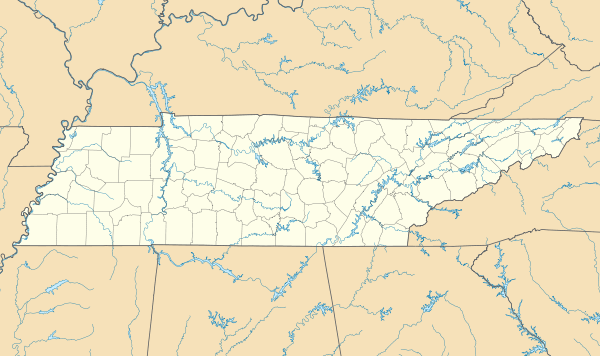Franklin Battlefield
|
Franklin Battlefield | |
|
View of the battlefield from atop Winstead Hill, which served as General Hood's headquarters | |
  | |
| Location | Franklin, Tennessee |
|---|---|
| Coordinates | 35°54′13″N 86°51′58″W / 35.90361°N 86.86611°WCoordinates: 35°54′13″N 86°51′58″W / 35.90361°N 86.86611°W |
| Architectural style | Greek Revival, Federal |
| NRHP Reference # | 66000734 |
| Significant dates | |
| Added to NRHP | October 15, 1966[1] |
| Designated NHLD | December 19, 1960[2] |
Franklin Battlefield was the site of the Second Battle of Franklin, which occurred late in the American Civil War. It is located in the southern part of Franklin, Tennessee, on U.S. 31. It was declared a National Historic Landmark in 1960.[2][3]
The Carter House, which stands today and is open to visitors, was located at the center of the Union position. The site covers about 15 acres (61,000 m2). The house and outbuildings still show hundreds of bullet holes. The Carnton Plantation, home to the McGavock family during the battle, also still stands and is likewise open to the public. Confederate soldiers swept past Carnton toward the left wing of the Union army, and the house and outbuildings were converted into the largest field hospital present after the battle. Adjacent to Carnton is the McGavock Confederate Cemetery, where 1,481 Southern soldiers killed in the battle are buried.
Adjacent to the 48 acres (190,000 m2) surrounding Carnton is another 110 acres (0.45 km2) of battlefield, which is currently being converted to a city park. Much of the rest of the Franklin battlefield has been lost to commercial development. The spot where Gen. Patrick Cleburne fell, for instance, was covered until late 2005 by a Pizza Hut restaurant. Although the restaurant was purchased by a preservation group and demolished, the Civil War Preservation Trust continues to rank the Franklin battlefield as one of the ten most endangered sites. City officials and historic-preservation groups have recently placed a new emphasis on saving what remains of the land over which this terrible battle raged.
Fort Granger is preserved in a 20-acre (8.1 ha) section that is listed on the National Register of Historic Places.
The battlefield is now preserved as part of the 110-acre (45 ha) Eastern Flank Battle Park, which is operated by the city of Franklin.
References
- ↑ National Park Service (2007-01-23). "National Register Information System". National Register of Historic Places. National Park Service.
- 1 2 "Franklin Battlefield". National Historic Landmark summary listing. National Park Service. Retrieved 2008-06-27.
- ↑ Cecil N. McKithan (November 5, 1982). "National Register of Historic Places Inventory-Nomination: Franklin Battlefield" (pdf). National Park Service. and Accompanying seven photos, from 1961 and undated (32 KB)
External links
- Eastern Flank Battle Park - City of Franklin
- Battle of Franklin, November 30, 1864
- Historic American Buildings Survey (HABS) No. TN-37, "Carter House, 1140 Columbia Avenue, Franklin, Williamson County, TN", 12 photos, 6 measured drawings, 9 data pages, supplemental material
- Historic American Landscapes Survey (HALS) No. TN-7, "The Landscapes of the Battlefield of Franklin, Tennessee, Franklin, Williamson County, TN", 1 measured drawing, 19 data pages
- HALS No. TN-7-A, "The Landscapes of the Battlefield of Franklin, Tennessee, Carnton Plantation, 1345 Carnton Lane", 2 measured drawings
- HALS No. TN-7-B, "The Landscapes of the Battlefield of Franklin, Tennessee, The Carter House, 1140 Columbia Avenue", 1 measured drawing
- HALS No. TN-7-C, "The Landscapes of the Battlefield of Franklin, Tennessee, Lotz House, 1111 Columbia Avenue", 1 measured drawing
